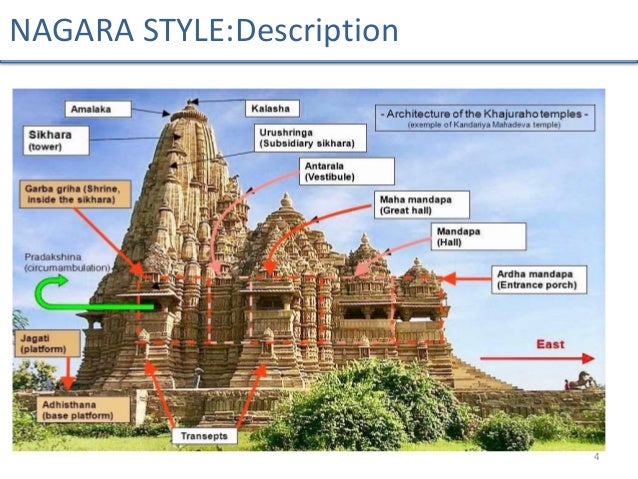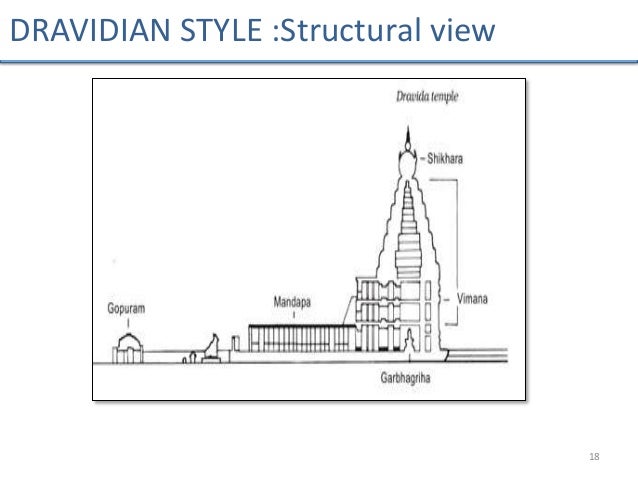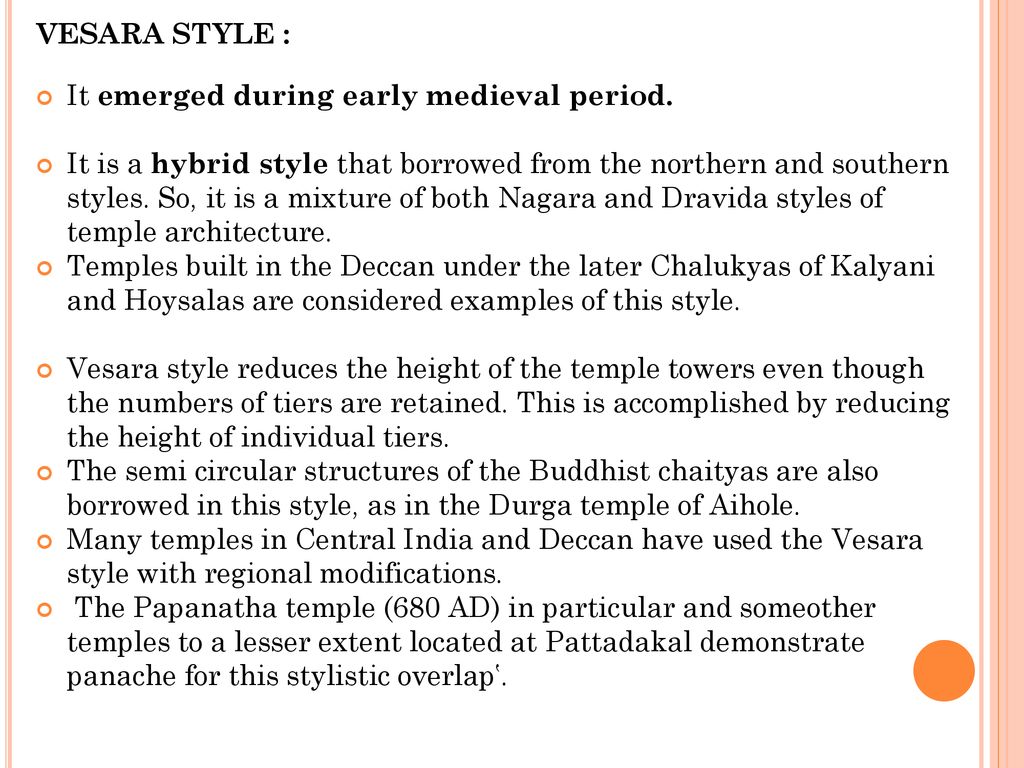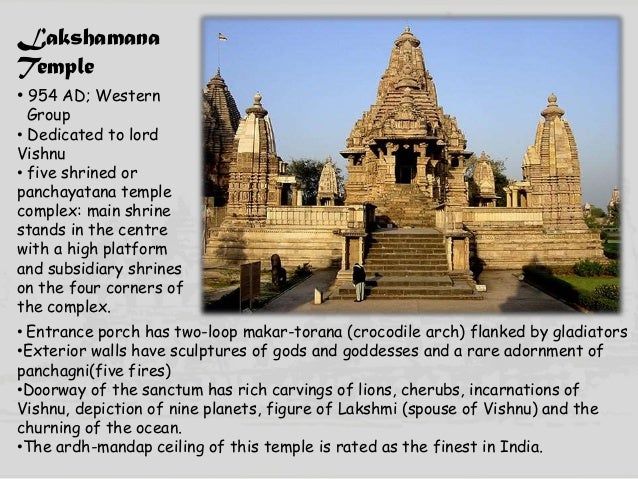Temples Architecture of India
Relevance: Prelims/Mains: G.S paper I: Art and Culture
Temples Architecture of India
Hindu temple architecture has many varieties of style, though the basic nature of the Hindu temple remains the same. Hindu temple architecture reflects a synthesis of arts, the ideals of dharma, beliefs, values and the way of life cherished under Hinduism.
Influenced by early Buddhist structures such as the stupa, the first Hindu temples were built from rock-cut caves. Then, with the arrival of Gupta architecture in the 4th to 5th century CE, the first free-standing Hindu temples were constructed with features such as towers and projecting niches.
The architectural principles of Hindu temples in India are described in Shilpa Shastra. Shilpa Shastra mentions three main type of temple architecture – Nagara or the Northern style, the Dravida or the Southern style and the Vesara or Mixed style.
Basic features of Indian Temples
The form and meanings of architectural elements in a Hindu temple are designed to function as the place where it is the link between man and the divine, to help his progress to spiritual knowledge and truth, his liberation it calls moksha.
Garbhagriha (Sanctum Sanctorum)
- It literally means womb-house and is a cave like sanctum.
- In the earliest temples, it was a small cubical structure with a single entrance.
- Later it grew into larger chambers.
- The Garbhagriha is made to house the main icon (main deity) which is itself the focus of much ritual attention.
Mandapa
- It is the entrance to the temple.
- It may be a portico or colonnaded (series of columns placed at regular intervals) hall that incorporate space for a large number of worshippers.
- Some temples have multiple mandapas in different sizes named as Ardhamandapa, Mandapa and Mahamandapa.
Shikhara or Vimana
- They are mountain like spire of a free standing temple.
- Shikhara is found in North Indian temples and Vimana is found in South Indian temples.
- Shikhara has a curving shape while Vimana has a pyramidal like structure.
Vahana
- It is the mount or vehicle of the temple s main deity along with a standard pillar or Dhvaj which is placed axially before the sanctum.
Amalaka
- It is a stone disc like structure crowning the top of the North Indian style shikhara.
Kalasha
- Wide-mouthed pot or ornamental pot-design decorating the shikhara in North Indian temples.
Antarala (vestibule)
- Antarala is a transition area between the Garbhagriha and the temple s main hall (mandapa).
Jagati
- It is a raised platform for sitting and praying and is common in North Indian temples.
Types of Hindu temples
Temple architecture evolved slightly differently in a different region. Shilpa Shastras mentions three main type of temple architecture. Three main styles of temple architecture are the Nagara or the Northern style, the Dravida or the Southern style and the Vesara or Mixed style. But at the same time, there are also some regional styles.
- Nagara (in North India) is associated with the land between the Himalayas and Vindhyas.
- Dravida (in South India) is associated with the land between the Krishna and Kaveri rivers.
- Vesara style as an independent style was created as a hybrid of Nagara and Dravida styles. It is associated with the land between the Vindhyas and the river Krishna.
Nagara style

The style of temple architecture that became popular in northern India is known as Nagara. Nagara style was developed regionally each region manifesting its own particular qualities. For example, various sub-styles of Nagara architecture are found vis- -vis Odisha School, Solanki School, and Khajuraho School etc.
- In Nagara style, it is common for an entire temple to be built on a stone platform with steps leading up to it.
- Unlike South Indian temples it does not usually have elaborate boundary walls or gateways.
- The three main distinctive features of Nagar style is Shikhara (Curvilinear tower), Garbhagriha (Sanctum Sanctorum), Mandapa (Entrance Hall)
- While the earliest temples had just one tower or shikhara, later temples had multiple Shikharas.
- The garbhagriha is always located directly under the tallest tower.
- Examples – Dashavatara temple (Deogarh), Vishwanatha temple (Khajuraho), Lakshman Temple (Khajuraho), Jagannath Temple (Puri)
Subdivision of Nagara temples based on the type of Shikhara
There are many subdivisions of Nagara temples depending on the shape of the shikhara.
Rekha-Prasadatype or Latinatype This type of temple has square shikhara at the base and its walls curve slowly inward towards the top. They are mainly used to house the main garbhagriha.
Phamsana type – Phamsana buildings tend to be broader and shorter than Latina ones. Their roofs are composed of several slabs that gently rise to a single point over the centre of the building, unlike the Latina ones which look like sharply rising tall towers. Phamsana roofs do not curve inward. Instead, they slope upwards on a straight incline. Phamsana design is used for the mandapas.
Valabhi type – These are rectangular buildings with a roof that rises into a vaulted chamber. The edge of this vaulted chamber is rounded, like the bamboo or wooden wagons that would have been drawn by bullocks in ancient times. They are usually called wagon vaulted buildings .

Dravida Style

Dravida style of temple architecture became popular in South India. Dravida style of temples was developed dynastically, however the major features of these temples remained common across the dynasties.
- Unlike the Nagara temple, the Dravida temple is enclosed within a compound wall.
- The front wall has an entrance gateway in its centre, which is known as a gopuram.
- The shape of the main temple tower known as Vimana is like a stepped pyramid that rises up geometrically rather than the curving shikhara of North India.
- In the South Indian temples, the word Shikhara is used only for the crowning element at the top of the temple which is equivalent to the amalaka and kalasha of North Indian temples.
- In the Dravida style temples, one will generally find sculptures of fierce dvarapalas or the door-keepers guarding the temple.
- It is common to find a large water reservoir, or a temple tank, enclosed within the complex.
- Subsidiary shrines are either incorporated within the main temple tower or located as distinct, separate small shrines beside the main temple.
- Unlike Nagara style, at some of the most sacred temples in South India, the main temple in which the garbhagriha is situated has, in fact, one of the smallest towers.
- Examples – Shore temple (Mahabalipuram), Brihadesvara temple (Thanjavur), Meenakshi Temple (Madurai)
Sub-divisions of Dravida temples based on shapes
There are basically five different shapes:
- Square, usually called Kuta or caturasra
- Rectangular or shala or ayatasra
- Elliptical or vrittayata also called gaja-prishta or elephantbacked
- Circular or vritta
- Octagonal or ashtasra
It must, however, be remembered that this is a simplistic differentiation of the subdivisions. Several different shapes may be combined in specific periods and places to create their own unique style.
Vesara Style

In the mid-seventh century, a distinct style of temple architecture grew in Karnataka region under the patronage of Chalukya rulers. The temples in this region follow a hybridised style which combines the features of both Nagara and Dravida styles.
- Vesara is a distinct stylistic tradition of Indian Hindu temple architecture primarily used in the Deccan and Central India, between the Vindhyas and the river Krishna
- Vesara style does not have an independent origin of its own and said to be an outgrowth of Dravida style.
- The Vesara style contains elements of both Dravida and Nagara styles. For example, Nagara and Dravida temples are erected side by side in Badami.
- Historians agree that the Vesara style originated in what is today Karnataka. According to some, the style was started by the Chalukyas of Badami. Therefore, it is also known as Chalukya style or Karnataka style of temple architecture. It was further improvised by Rashtrakuta and Hoysala dynasties.
- The height of these temples was reduced compared to its Nagara and Dravida counterparts. The height of the temple tower over the sanctum is usually shorter than the Vimanas in Dravida temples. They can be referred as miniature Vimanas. The shape of these towers was pyramidal in profile.
- Vimana was crowned by a circular shikhara above the neck.
- Examples – Badami temple, Durga Temple (Aihole), Virupaksha Temple (Pattadkal), Keshava Temple (Somnathpur)

For more such notes, Articles, News & Views Join our Telegram Channel.
Click the link below to see the details about the UPSC –Civils courses offered by Triumph IAS. https://triumphias.com/pages-all-courses.php



